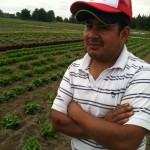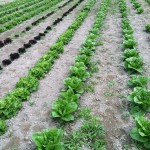Ten years ago, Salvador Morales tried to start a farm with his brother. Since they were boys, their family had earned a living from farm work. They’d picked everything from cauliflower to cucumbers to berries. At 17, he struck a deal to begin growing his own vegetables on another landowner’s property in Bow, Washington.
A lifetime of fieldwork may teach you how to grow monster tomatoes or cut hundreds of heads of lettuce. But it doesn’t necessarily prepare you for running a farm. Once it came time to harvest, the brothers realized they were missing an essential part of the business equation: paying customers. As Morales remembers it:
Nothing really happened. I thought we would sell in big markets, but I didn’t really have any idea how to do it.
They assumed that local Mexican restaurants would buy their produce, but kitchen managers already had relationships with large and established distributors. The natives of Oaxaca, Mexico, spoke Mixtec as their first language and couldn’t communicate well with buyers who spoke English or even Spanish. So Morales gave up on the dream of being his own boss, at least for the next few years.
He’s at the crux of a sticky problem: The average age of farm operators is 57 in the Northwest. The vast majority of them are white. Most of them plan to retire in the next two decades. And not that many of them have children who want to come home and run things. So who exactly are we counting on to become the next generation of farm owners?
One logical answer is the workers who already grow and process most of our food. The vast majority of them are Hispanic. More would like the opportunity to go into business for themselves, but don’t have land, language, or business experience. Though the number of Latino farm operators is still small, they’re one of the fastest growing slices of new farmers in Washington State. Here’s how Sarita Schaffer, regional coordinator of Washington State University’s Latino farming program, describes it:
I do think that Latino farmers are one of the main faces of the future of agriculture. Even in the more established farms if you start to look at their managers, they’re now second-generation Latino farmers. But immigrant farmers aren’t inheriting land. It’s a basic asset for starting to farm. It’s really difficult to get into farming without it, no matter how good you are.
Language is a huge barrier as well. It’s possible to live here for 20 years and never learn English. Farmworkers are so immersed in their own communities, and on their jobs they’ll have a Spanish-speaking supervisor. They don’t have a lot of spare time to go take ESL classes. If you’re feeding a family and trying to send money home to Mexico, any spare time you’re going to spend looking for work.
So approaching customers is nervewracking. It’s terrifying enough in English if you’ve seen a new farmer make a cold call or talk to someone about their product. Just add the nervousness of language to that.
So how exactly did Morales become what he is today: a new farm owner who’s found a business niche, learned how to cultivate and negotiate with customers, and is hoping to hire employees next growing season?
Getting a good price

On an August afternoon, Morales and a colleague at the Viva Farms incubator near Burlington, WA were working on an ancient red tractor, trying to devise a better weeding tool. He borrowed a knife and walked through the fields to impeccably neat rows of salad greens that he and his brother are selling to restaurants, a regional Community Supported Agriculture (CSA) program and local farm stand on the property.
The farm incubator near Burlington, WA, now in its fourth growing season, gives aspiring farmers access to affordable irrigated land, shared equipment, farming and business training, and guaranteed markets for their crops. (This video provides a good overview and some personal stories of some of the farmers.)
Like most of the growers there, the Morales brothers first took farming and agricultural entrepreneurship classes, which cover everything from fighting pests without chemicals to building healthy soils to designing a logo to working with spreadsheets. The classes, which are offered simultaneously in Spanish and English in Skagit County, helped the former farmworkers identify a niche for their own business that would focus on lettuces and greens.
People who graduate with solid business plans—which include Latino agricultural workers, carpenters put out of work by the housing bust, and unfulfilled professionals looking to change gears—can rent plots of irrigated land next to the local airport. They share expensive infrastructure, from a greenhouse that keeps seedlings warm in spring to cold storage that keeps lettuce from wilting in the sun, that would normally be out of financial reach for new farmers. It’s a place that allows them to see what sells, learn market realities, and make mistakes without having their entire life savings on the line.

One early lesson that farm managers learned was that language and cultural barriers made it difficult for Latino farmers to approach and cultivate new customers. And they naturally gravitated towards wholesale markets, processors, or canneries that regularly work with Latinos but pay growers less than markets or produce subscriptions that sell directly to consumers. (This echoes findings from this survey of Latino farm owners in Eastern Washington, which found that while many former farmworkers are well equipped to produce food, many have serious gaps in understanding and managing the business side.)
To solve that problem, Viva Farms developed a distribution arm that buys produce directly from its farmers and provides them with some guaranteed income while they grow their customer base. It supplies a regional CSA that delivers weekly food boxes to subscribers and Viva’s produce stand that sits on a busy stretch of Hwy. 20. Soon after it opened, it was selling $1,000 worth of fruit and vegetables a day.
Morales and his brother sell to those Viva channels, which have been critical to the incubator’s success and provide fledgling farmers with at least some steady income. The brothers have also developed relationships on their own with restaurants and other customers. The support and hands-on experience they’ve gotten has made them far more comfortable dealing with buyers, Morales said.
My parents didn’t know about business. They knew how to work the fields. My experience here is that we’re learning a lot about markets – how to negotiate with people, how to get a good price, what kind of treatment we should have.
‘I think it’s beautiful’

Viva Farms hosts both Latino and Anglo farmers. But the former farmworkers have some distinct advantages, starting in many cases with a life’s education in crop production. They’re accustomed to making do with whatever’s on hand, like turning a riding lawnmower into a mini tractor. As Schaffer puts it, “there’s a comfort with tools and making something out of nothing and being really creative.” They have the ability to source labor from their family or community when big jobs or harvests need to be done.
But they have to negotiate the same challenges that any small business owner faces, from obtaining licenses to paying taxes to raising capital. Some growers have never used a computer before, and many grew up in cash-based societies in Latin America. After talking with one farmer about the importance of saving money for the next growing season, Schaffer later discovered that he had been saving checks in a drawer rather than depositing them. Even USDA loans aimed at “beginning” farmers require three years worth of sales and tax receipts. To help farmers begin to establish a credit history, Viva has developed a new micro-loan program through a local credit union that allows its farmers to borrow money to pay for packing supplies or labor early in the growing season.
And there is still plenty of trial and error in discovering how to grow crops most efficiently. Most Latino farmworkers spend their careers in conventional agricultural fields, and are unfamiliar with organic or sustainable practices that can benefit smaller-scale growers. As Schaffer said:
They want to get rid of the pesticides because they know having worked around them for years that they’re bad, plus customers will pay a premium. But it’s sort of like someone going vegetarian for the first time—the first thing they focus on is just getting rid of the meat without understanding what they should replace it with or complex vegetable proteins. So there’s a lot to learn about complicated soil amendments and pests and taking different approaches.

Morales has had his share of trial and error, but says growing lettuce is easy compared to the paperwork a business owner has to keep up with. That part of the job he may never like. But for now, he looks at his fields and feels happy.
I look at all this lettuce and think it is beautiful. I didn’t have the opportunity to finish school, and I think this is an opportunity for us to be a business owner without that much education. The lettuce has all the education. I only take care of them. I love them and they love me back.
Note: Special thanks to interpreter Victoria Castaneda, who translated between English and Spanish during interviews for this blogpost.


Comments are closed.